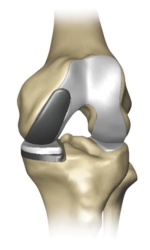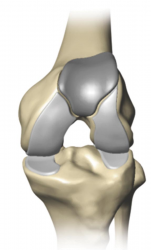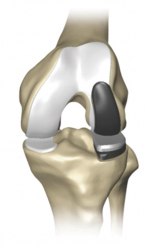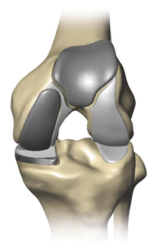Partial Knee Replacement: Difference between revisions
No edit summary |
No edit summary |
||
| Line 22: | Line 22: | ||
== Diagnostic Tests == | == Diagnostic Tests == | ||
X-ray and MRI of the joint will reveal the <br> | X-ray and MRI of the joint will reveal the joint disease resulting from Degenerative, Rheumatoid or any Post traumatic arthritis, and also moderate deformity of the Knee. <br> | ||
== Pre-Op == | == Pre-Op == | ||
Revision as of 11:18, 23 February 2017
Original Editor - Venugopal Pawar
Top Contributors - Venugopal Pawar, Ahmed Nassef, Kim Jackson, Lucinda hampton, 127.0.0.1, Admin, Selena Horner, George Prudden, WikiSysop, Leana Louw and Lauren Lopez
Description
[edit | edit source]
A partial knee replacement (PKR) is a surgical procedure to replace only one part of a damaged knee. It can replace either the inside (medial) part, the outside (lateral) part, or the kneecap (Patellofemoral) part of the knee.
With PKR, only the damaged area of the knee joint is replaced, which may help to minimize trauma to healthy bone and tissue, and also helps relieve arthritis in on or two of the three compartments of the knee.
Surgery to replace the whole knee joint is called total knee replacement.
Indication
[edit | edit source]
Partial Knee Replacement is intended for use in individuals with joint disease resulting from Degenerative, Rheumatoid and Post traumatic arthritis, and for moderate deformity of the Knee.
Clinical Presentation[edit | edit source]
People with advanced osteoarthritis and conservative treatments have been exhausted.[1] mild valgus or varus deformity. Pain is often noted when performing physical activities requiring a wide range of motion in the knee joint.[2]
Diagnostic Tests[edit | edit source]
X-ray and MRI of the joint will reveal the joint disease resulting from Degenerative, Rheumatoid or any Post traumatic arthritis, and also moderate deformity of the Knee.
Pre-Op[edit | edit source]
add text here relating to the pre-operative advice
Surgical Procedure & Types of Partial Knee Replacement.[edit | edit source]
add text here relating to post-operative rehabilitation
Types:[edit | edit source]
MEDIAL PATELLOFEMORAL LATERAL BICOMAPRMENTAL
- Unicondylar Knee Replacement is a procedure that replaces only the single affected compartment of the knee, either the medial or lateral compartment.
- Patellofemoral Knee Replacement is a procedure that replaces the worn patella (the kneecap) and the trochlea (the groove at the end of the thighbone).
- Bicompartmental Knee Replacement is a procedure that replaces two compartments of the knee, the medial and patellofemoral compartments.
Contra-indications & Common side-effects Key Evidence[edit | edit source]
add text here relating to key evidence with regards to any of the above headings
- Partial Knee EReplacement surgery is not appropriate for patienst with certain types of Infections, any mental or Nueromuscular disorder which would create an unacceptable risk of prosthesis instability, prosthesis fixation failure or complication in postoperative care, skeletal immaturity, severe instability of the knee or Excessive body weight.
- Comom side effects:as with any surgery, PKR has its risks which may be Implant related risks which may lead to a revision include dislocation, loosening, fracture, nerve damage, heterotropic ossification, wear of the implant, metal sensitivity, soft tissue imbalance, osteolysis(localized progressive bone loss) and reaction to particle debris.
- Knee implants may not provide the same feel or performance characteristics experienced with a normal healthy joint.
Resources
[edit | edit source]
add appropriate resources here
Case Studies[edit | edit source]
add links to case studies here (case studies should be added on new pages using the case study template)
Recent Related Research (from Pubmed)[edit | edit source]
Extension:RSS -- Error: Not a valid URL: Feed goes here!!|charset=UTF-8|short|max=10
References[edit | edit source]
References will automatically be added here, see adding references tutorial.
- ↑ Van Manen, MD; Nace, J; Mont, MA (November 2012). "Management of primary knee osteoarthritis and indications for total knee arthroplasty for general practitioners.". The Journal of the American Osteopathic Association. 112 (11): 709–715. PMID 23139341.
- ↑ Deyle GD, Henderson NE, Matekel RL, Ryder MG, Garber MB, Allison SC (February 2000). "Effectiveness of manual physical therapy and exercise in osteoarthritis of the knee. A randomized, controlled trial". Ann. Intern. Med. 132 (3): 173–81. doi:10.7326/0003-4819-132-3-200002010-00002. PMID 10651597.










